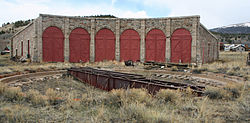
The Denver and Rio Grande Western Railroad, often shortened to Rio Grande, D&RG or D&RGW, formerly the Denver & Rio Grande Railroad, was an American Class I railroad company. The railroad started as a 3 ft narrow-gauge line running south from Denver, Colorado, in 1870. It served mainly as a transcontinental bridge line between Denver and Salt Lake City, Utah. The Rio Grande was also a major origin of coal and mineral traffic.

Denver Union Station is the main railway station and central transportation hub in Denver, Colorado. It is located at 17th and Wynkoop Streets in the present-day LoDo district and includes the historic station house, a modern open-air train shed, a 22-gate underground bus station, and light rail station. A station was first opened on the site on June 1, 1881, but burned down in 1894. The current structure was erected in two stages, with an enlarged central portion completed in 1914.
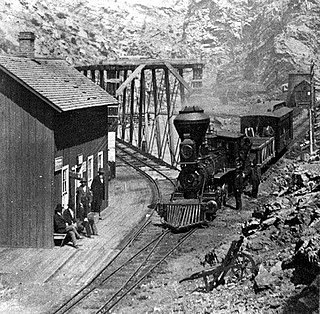
The Colorado Central Railroad was a U.S. railroad company that operated in Colorado and southeastern Wyoming in the late 19th century. It was founded in the Colorado Territory in the wake of the Colorado Gold Rush to ship gold from the mountains. It expanded from its Golden–Denver line to form a crucial link connecting Colorado with the transcontinental railroad and the national rail network. The history of the railroad throughout the 1870s was driven at times by a fierce struggle between local interests, led by W.A.H. Loveland, and outside investors of the Union Pacific Railroad led at times by Jay Gould. The early struggle of the company to build its lines was a major part of the early competition between Denver and Golden for supremacy as the principal metropolis of Colorado.

The Denver, South Park, and Pacific Railroad was a historic 3 ft narrow gauge railroad that operated in Colorado in the western United States in the late 19th century. The railroad opened up the first rail routes to a large section of the central Colorado mining district in the decades of the mineral boom. The railroad took its name from the fact that its main line from Denver ascended the Platte Canyon and traversed South Park, hence its popular name "The South Park Line." Despite its lofty goals, the line never connected itself with the Pacific or any transcontinental line, apart from its terminal at Denver Union Station.

The Georgetown Loop Railroad is a 3 ft narrow gauge United States heritage railroad located in the Rocky Mountains in Clear Creek County, adjacent to Interstate 70 in Colorado.

Como is an unincorporated community in Park County in the Rocky Mountains of central Colorado, United States. According to the 2010 census, the population of zip code 80432 is 439, including surrounding subdivisions in a 15 mile radius. Metropolitan Como proper usually has a population of 12 to 15 residents, within the Como plat.

Boreas Pass is a high mountain pass in central Colorado, in the Rocky Mountains of the western United States. The pass is located on the continental divide, at the crest of the Front Range along the border between Park (south) and Summit counties.

The Cumbres and Toltec Scenic Railroad, often abbreviated as the C&TSRR, is a 3 ft narrow-gauge heritage railroad that operates on 64 miles (103 km) of track between Antonito, Colorado, and Chama, New Mexico, in the United States. The railroad is named for two geographical features along the route: the 10,015-foot (3,053 m)-high Cumbres Pass and the Toltec Gorge. Originally part of the Denver and Rio Grande Western Railroad's narrow-gauge network, the line has been jointly owned by the states of Colorado and New Mexico since 1970. Today, the C&TSRR is one of only two remaining parts of the former D&RGW narrow-gauge network, the other being the Durango and Silverton Narrow Gauge Railroad (D&SNG), which runs between the communities of Durango and Silverton, Colorado. The railroad has a total of ten narrow-gauge steam locomotives and two narrow-gauge diesel locomotives on its current roster. The railroad also operates two smaller former D&RGW steam locomotives, Nos. 315 and 168, for special events and excursions.

The Durango and Silverton Narrow Gauge Railroad, often abbreviated as the D&SNG, is a 3 ft (914 mm) narrow-gauge heritage railroad that operates on 45.2 mi (72.7 km) of track between Durango and Silverton, in the U.S. state of Colorado. The railway is a federally-designated National Historic Landmark and was also designated by the American Society of Civil Engineers as a National Historic Civil Engineering Landmark in 1968.

Alpine Tunnel is a 1,772 ft (540 m) narrow gauge railroad tunnel located east of Pitkin, Colorado, on the former Denver, South Park and Pacific Railroad route from Denver to Gunnison. At an elevation of 11,523 feet (3,512 m), it was the first tunnel constructed through the Continental Divide in Colorado, and according to the U.S. Forest Service "remains the highest railroad tunnel and the longest narrow gauge tunnel in North America." However, it did not last long in service. Construction began in January 1880 and was scheduled to last for six months but instead dragged on until July 1882, and the line was abandoned in 1910 due to minor damage in the tunnel. Now the tunnel is sealed shut and the remaining trackbed serves as a trail for hikers and bicyclists.
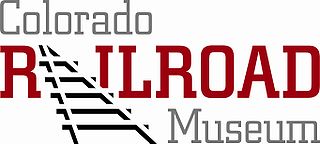
The Colorado Railroad Museum is a non-profit railroad museum. The museum is located on 15 acres (6.1 ha) at a point where Clear Creek flows between North and South Table Mountains in Golden, Colorado.

The Sumpter Valley Railway, or Sumpter Valley Railroad, is a 3 ft narrow gauge heritage railroad located in Baker County, in the U.S. state of Oregon. Built on a right-of-way used by the original railway of the same name, it carries excursion trains on a roughly 5-mile (8.0 km) route between McEwen and Sumpter. The railroad has two steam locomotives and several other pieces of rolling stock. Passenger excursion trains operate on weekends and holidays from Memorial Day through the end of September.

The East Broad Top Railroad (EBT) is a 3 ft narrow gauge historic and heritage railroad headquartered in Rockhill Furnace, Pennsylvania.

There are more than 1,500 properties and historic districts in the U.S. State of Colorado listed on the National Register of Historic Places. They are distributed over 63 of Colorado's 64 counties; only the City and County of Broomfield currently has none.

The Colorado and Southern Railway was an American Class I railroad in the western United States that operated independently from 1898 to 1908, then as part of the Chicago, Burlington and Quincy Railroad until it was absorbed into the Burlington Northern Railroad in 1981.
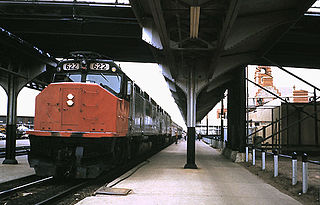
The Cheyenne Depot Museum is a railroad museum in Cheyenne, Wyoming, United States. It is located inside the 1880s Union Pacific Railroad depot. A National Historic Landmark, the station was the railroad's largest west of Council Bluffs, Iowa, and a major western example of Richardsonian Romanesque architecture.

The Royal Gorge Route Railroad is a heritage railroad based in Cañon City, Colorado. A 1950s-era train makes daily 2-hour excursion runs from the Santa Fe Depot through the Royal Gorge along a famous section of the former Denver and Rio Grande Western Railroad.

The Nevada–California–Oregon Railway was a 3 ft narrow gauge railroad originally planned to connect Reno, Nevada, to the Columbia River. However, only 238 mi (383 km) of track were laid so service never extended beyond Lakeview, Oregon. Because of the company’s reputation for mismanagement, it was often called the "Narrow, Crooked & Ornery" railroad.
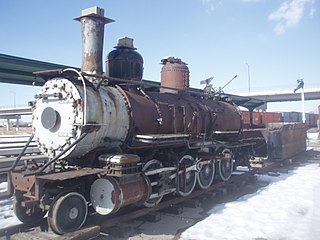
Denver and Rio Grande Western 223 is a 2-8-0 "Consolidation" type narrow-gauge steam railway locomotive built for the Denver and Rio Grande Railroad by the Grant Locomotive Works of Paterson, New Jersey in 1881-82. Number 223 was completed in December 1881, at a cost of $11,553. Baldwin built an additional 25 locomotives in the same class at the same time.
